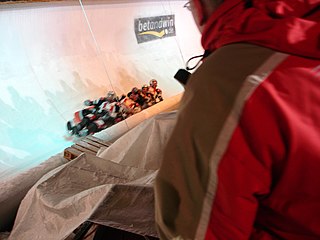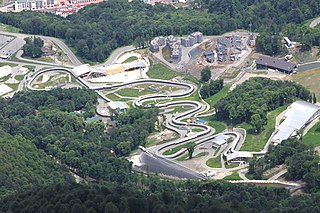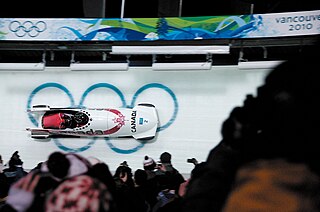
A luge is a small one- or two-person sled on which one sleds supine (face-up) and feet-first. A luger begins seated, propelling themselves initially from handles on either side of the start ramp, then steers by using the calf muscles to flex the sled's runners or by exerting opposite shoulder pressure to the pod. Racing sleds weigh 21–25 kg (46–55 lb) for singles and 25–30 kg (55–66 lb) for doubles. Luge is also the name of an Olympic sport that employs that sled and technique.

Skeleton is a winter sliding sport in which a person rides a small sled, known as a skeleton bobsled, down a frozen track while lying face down and head-first. The sport and the sled may have been named from the bony appearance of the sled.

Shelley Rudman is a skeleton bobsleigh athlete who was the 2013 world champion in the event. She won a silver medal at the 2006 Winter Olympics, and is a former World Cup and European champion.

Mellisa Hollingsworth is a retired Canadian athlete who competed from 1995 to 2014. She won the bronze medal in the women's skeleton event at the 2006 Winter Olympics in Turin.

Amy Joy Williams, is a British former skeleton racer and Olympic gold medallist. Originally a runner, she began training in skeleton in 2002 after trying the sport on a push-start track at the University of Bath. Although unable to qualify for the 2006 Winter Olympics, she was a member of the Great Britain team four years later at the 2010 Games. She won a gold medal, becoming the first British individual gold medallist at a Winter Olympics for 30 years and the only British medallist in those Olympics.

Noelle Pikus-Pace is an American retired skeleton racer who began her career in 2001. She won five medals at the FIBT World Championships, competed in the 2010 Winter Olympics in Vancouver, and won the silver medal in the 2014 Winter Olympics in Sochi.
Nicola Minichiello is a retired British bobsledder who competed between 2001 and 2011. She won two medals in the two-woman event at the FIBT World Championships, winning a silver in 2005 and making history with a gold in 2009 partnering Gillian Cooke, to become the first British female bobsleigh driver to win a World Championships. Competing in three Winter Olympics, Minichiello earned her best finish of ninth in the two-woman event at Turin in 2006. This was also the best ever Olympic result by a GB women’s bobsleigh team.
Ryan Davenport is a Canadian skeleton racer who competed from 1993 to 1999. He won three medals in the men's skeleton event at the FIBT World Championships with two golds and one bronze (1995).
The FIBT World Championships 2008 ran February 11–24, 2008 in Altenberg, Germany for the fifth time, having done so in 1991 (bobsleigh), 1994 (skeleton), 1999 (skeleton), and 2000. It is the first time Altenberg has hosted all of those events at one championship, and also includes the mixed team event that debuted at the 2007 championships. Training for the events took place February 12–14 for two-man and two-woman bobsleigh, and February 19–20 for skeleton and four-man bobsleigh.
The FIBT World Championships 2009, officially known as the Bauhaus FIBT Bobsleigh & Skeleton World Championships, February 20 to March 1, 2009, at the bobsleigh, luge, and skeleton track in Lake Placid, New York, for the ninth time, doing so previously in 1949, 1961, 1969, 1973, 1978, 1983, 1997 (skeleton), and 2003. Lake Placid was chosen 25–11 over Igls, Austria.

The Königssee bobsleigh, luge, and skeleton track is a venue in Germany for bobsleigh, luge and skeleton, located in Schönau am Königssee, Bavaria, near Königssee and the border with Austria. Completed 57 years ago in 1968, it is the first permanent, artificially refrigerated bobsleigh, luge, and skeleton track in the world. In July 2021, the track was severely damaged by the floods that affected the European continent, and is currently under reconstruction.

The Olympic Sliding Centre Innsbruck is a venue for bobsleigh, luge and skeleton located in Igls, Austria. The most recent version of the track was completed in 1975 and is the first permanent, combination artificially refrigerated bobsleigh, luge, and skeleton track, serving as a model for other tracks of its kind worldwide. It hosted the bobsleigh, luge, and skeleton competitions for the 2012 Winter Youth Olympics.

The Whistler Sliding Centre is a Canadian bobsleigh, luge, and skeleton track located in Whistler, British Columbia, that is 125 km (78 mi) north of Vancouver. The centre is part of the Whistler Blackcomb resort, which comprises two ski mountains separated by Fitzsimmons Creek. Located on the lowermost slope of the northern mountain, Whistler Sliding Centre hosted the bobsleigh, luge, and skeleton competitions for the 2010 Winter Olympics.

The Sliding Center Sanki (Санки) is a bobsleigh, luge, and skeleton track located in Rzhanaya Polyana, Russia, 60 km (37 mi) northeast of Sochi. Located in the Western Caucasus. The venue hosted the bobsleigh, luge, and skeleton events for the 2014 Winter Olympics.
The skeleton competition of the Vancouver 2010 Olympics was held at Whistler Sliding Centre. The events were held between the 18 and 19 February 2010. This event was expanded to four runs over two days beginning at these Olympic Games.
The women's skeleton at the 2006 Winter Olympics took place on 16 February, at the Cesana Pariol.

The two-man bobsleigh competition at the 2010 Winter Olympics in Vancouver, British Columbia, Canada, was held at the Whistler Sliding Centre in Whistler, British Columbia on 20–21 February. The German team of André Lange and Kevin Kuske were the defending Olympic champions in this event. Switzerland's team of Ivo Rüegg and Cedric Grand were the defending world champions in this event. The test event held at the Olympic venue was won by the German duo of Thomas Florschütz and Marc Kühne. The last World Cup event prior to the 2010 Games took place in Igls, Austria on 23 January 2010 and was won by the Swiss duo of Beat Hefti and Thomas Lamparter while Rüegg won the overall World Cup in the two-man event.

The four-man bobsleigh competition at the 2010 Winter Olympics in Vancouver, British Columbia, Canada, was held at the Whistler Sliding Centre in Whistler, British Columbia, on 26–27 February. The German team of André Lange, René Hoppe, Kevin Kuske, and Martin Putze were the defending Olympic champion in this event. America's team of Steve Holcomb, Justin Olsen, Steve Mesler, and Curtis Tomasevicz were the defending world champions in this event. The test event was won by the Latvian team of Jānis Miņins, Daumants Dreiškens, Oskars Melbardis, and Intars Dambis. The last World Cup event prior to the 2010 Games place took place in Igls, Austria on 24 January 2010 and was won by the German team of Lange, Hoppe, Kuske, and Putze. Holcomb of the United States won both the four-man and the combined World Cups.

The two-woman bobsleigh competition at the 2010 Winter Olympics in Vancouver, British Columbia, Canada, was held at the Whistler Sliding Centre in Whistler, British Columbia, on 20–21 February.

The men's skeleton event at the 2010 Winter Olympics in Vancouver, Canada, took place at the Whistler Sliding Centre on 18–19 February. Canada's Duff Gibson was the defending Olympic champion. Gibson retired after the 2006 Olympics. Switzerland's Gregor Stähli, the defending Olympic bronze medalist was the defending world champion, but did not compete due to a thigh injury sustained during the World Cup event in Lake Placid, New York, on 20 November 2009. The test event held at the venue was won by Jon Montgomery of Canada. The last World Cup event prior to the 2010 Games took place in Igls, Austria, on 23 January 2010 and was won by Latvia's Martins Dukurs who also won the overall World Cup title.

















